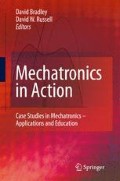Abstract
Systems are becoming more and more complex and there is an ever increasing need to address all relevant issues beginning with the initial conceptual design stage. If a complex system having precision mechanical components, electronic circuitry and control software is considered in detail, it is appreciated that there is a close relation and interaction between these elements in the system. Consider a complex mechatronic system having all of the aspects referred to above and which is going to be used in association with a complex biological system. In this case, there needs to be a close relationship with and interaction between the biological system and the mechatronic system, requiring that a biomechatronic approach is adopted in its design and development. Such an approach could also be used in other instances such as the design and development of complex mobile robots2. The human body combines intelligence with sophisticated sensors and actuators, making it the most logical source of inspiration and study when designing and developing many intelligent systems.
In this chapter, an overview will be given of biomechatronics and the approach to the design and development of intelligent systems. As the case study is that of lower limb prosthetics, a brief description is given of human lower limb functions. Prosthetics are then reviewed and analysed as an example of a biomechatronic system.
Access this chapter
Tax calculation will be finalised at checkout
Purchases are for personal use only
Preview
Unable to display preview. Download preview PDF.
References
French MJ, (1994) Invention and Evolution; Design in Nature and Engineering, Cambridge University Press
en.wikipedia.org/wiki/Bionic
Online Oxford dictionary; dictionary.oed.com/cgi/entry/50022356?single=1&query_type=word&queryword=Bionics& first=1&max_to_show=10
en.wikipedia.org/wiki/Biomimetics
Online Oxford dictionary //dictionary.oed.com/cgi/entry/20002098?query_type=word&queryword=Bionics&first=1& max_to_show=10&single=1&sort_type=alpha
en.wikipedia.org/wiki/Biomechatronics
en.wikipedia.org/wiki/Human_body
Royston A (1998) Essential facts, Human body, Parragon
Anatomica; the complete human medical reference, Konemann
Oxford dictionary
Online Nursing and Allied Health encyclopaedia www.enotes.com/nursing-encyclopedia/lower-limb-prostheses
Whittle MW (2001) Gait analysis, an introduction, 3rd edition, Oxford: Butterworth-Heinemann
Online Nursing and Allied Health encyclopaedia www.enotes.com/nursing-encyclopedia/gait and balance assessment
Kirby RL, Stewart-Gray JF, Creaser GA (1985) Usefulness of footprint-sequence analysis in lower-limb amputees, Physical Therapy, 65(1):31–34
Ayyappa E (1997) Normal Human Locomotion, part1: Basic concepts and terminology, J. Prosthetics and Orthotics, 9(1):10
Ayyappa E (1997) Normal Human Locomotion, part2: Motion, ground reaction force and muscle activity, J. Prosthetics and Orthotics, 9(2):49
Saunders JB, Inman VT, Eberhart HD (1953) The major determinants in normal and pathological gait, JBJS, 35-A:543–58
Inman V, Ralston HJ, Todd F (1981) Human walking, Williams and Wilkins, Baltimore:1–128.
Perry J (1992) Gait analysis; normal and pathological function, Slack:3-129 (chapters 1–6)
emedicine.medscape.com/article/320160overview#section~PathologicalGait
Orthotics and Prosthetics Online (2006) Materials Science: Producing Lighter, More Cosmetically Appealing O&P Devices, The O&P EDGE. www.oandp.com/edge/issues/articles/200608_01.asp?searchquery=Ultralight+prostheses)
Rothschild VR, Fox JR, Michael JW, Rothschild RJ, Playfair G (1991) Clinical experience with total thermoplastic lower limb prostheses, J. Prosthetics and Orthotics, 3(1):51
Pithawa AK, Singh BG, Ravindranath BG (2006) Clinical appraisal of indigenous below knee endoskeletal carbon fibre prosthesis, Medical J. Armed Forces India, 62(2)
www.amputee-coalition.org/military-instep/cosmesis.html
www.emedicine.com/asp/dictionary.asp?keyword=proprioception
Jinung A (2003) Modelling of a magnetorheological actuator including magnetic hysteresis, J. Intelligent Materials and Systems, 14(9):541–550.
Pratt GA, Williamson MM (1995) Series Elastic Actuators, IROS 95, Pittsburgh
www.endolite.co.uk/products/knees/smart_adaptive/smart_adaptive.html
www.cleg.ottobock.com/index.php?id=67&L=1
www.ossur.com/lisalib/getfile.aspx?itemid=6996
Zahedi S, Sykes A, Lang S, Cullington I (2005) Adaptive prosthesis – a new concept in prosthetic knee control, Robotica, 23:337–344.
Zahedi S, Lower limb prosthetic research in the 21st century, ATLAS of prosthetics. www.endolite.co.uk/clinical_studies/clinical_studies_pdf/Lower_Limb.pdf
Herr H, Wilkenfeld A (2003) User-adaptive control of a magnetorheological prosthetic knee, Industrial Robots, 30(1):42–55.
Au SK, Weber J, Herr H (2007) Biomechanical design of a powered ankle-foot prosthesis, Proc. 10th Int. Conf. on Rehabilitation Robotics, ICORR2007:298–303.
Au SK, Bonato P, Herr H (2005) An EMG-position controlled system for an active anklefoot prosthesis: An initial experimental study, 9th Int. Conf. on Rehabilitation Robotics, ICORR2005
Sup F, Varol HA, Mitchell J, Withrow TJ, Goldfarb M (2009) Self-Contained Powered Knee and Ankle Prosthesis:, 11th Int. Conf. On Rehabilitation Robotics, ICORR 2009, Paper 0024
Abadi S, Dehghani A, Nelson EA (2007) Venous ulceration and the measurement of movement, Abstracts 16th Annual Meeting of the European Tissue Repair Society (ETRS), In Wound Repair and Regeneration 15:A73
Abadi S, Nelson EA, Dehghani A (2007) Emerging Technologies in the Measurement of Lower Limb Movement in Relation to Venous Ulceration, Abstracts of 17th Annual Meeting of the European Tissue Repair Society (ETRS), In Lower Extremity Wounds, 6 (3):187–188.
Abadi S, Nelson EA, Dehghani A (2007) Venous Ulceration and the Measurement of Movement: A Review, J. Wound Care 16(9); 396–402
Young AD, Ling M, Arvind DK (2007) Orient-2: A real-time wireless posture tracking system using local orientation estimation, 4th Workshop on Embedded Networked Sensors; 53–57
Arvind DK, Bates A (2008) The speckled golfer, Proc. 3rd ICST Int. Conf. on Body Area Networks, Tempe, Article No 28
Kuiken TA, Dumanian GA, Lipschutz RD, Miller LA, Stubblefield KA (2005) Targeted muscle reinnervation for improved myoelectric prosthesis control, Proc. 2nd Int. EMBS Conference on Neural Engineering
en.wikipedia.org/wiki/Targeted_reinnervation
Aaron RK, Herr H, Ciombor DMK, Hochberg LR, Donoghue JP, Briant CL, Morgan JR, Ehrlich MG (2006) Horizons in Prosthesis Development for the Restoration of Limb Function, J. the American Academy of Orthopaedic Surgeons, 14(10):198–204
Bar-Cohen Y (2004) Bionic Humans Using EAP as Artificial Muscles Reality and Challenges; Int. J. Advanced Robotic Systems, 1(3):217–222.
Herr H, Kornbluh R (2004) New horizons for orthotic and prosthetic technology: artificial muscle for ambulation; Smart Structures and Materials: Electroactive Polymer Actuators and Devices (EAPAD), Proc. SPIE, 5385:1–9.
Abadi S, Dehghani A, Nelson EA (2008) A Soft Sensing Method for Monitoring Ambulatory Activities of Patients with Venous Ulceration, 4th IET Int. Conf. on Advances in Medical Signal and Image Processing, Santa Margharita
Author information
Authors and Affiliations
Editor information
Editors and Affiliations
Rights and permissions
Copyright information
© 2010 Springer-Verlag London Limited
About this chapter
Cite this chapter
Dehghani, A. (2010). Intelligent Prosthesis – a Biomechatronics Approach. In: Bradley, D., Russell, D. (eds) Mechatronics in Action. Springer, London. https://doi.org/10.1007/978-1-84996-080-9_11
Download citation
DOI: https://doi.org/10.1007/978-1-84996-080-9_11
Publisher Name: Springer, London
Print ISBN: 978-1-84996-079-3
Online ISBN: 978-1-84996-080-9
eBook Packages: EngineeringEngineering (R0)

